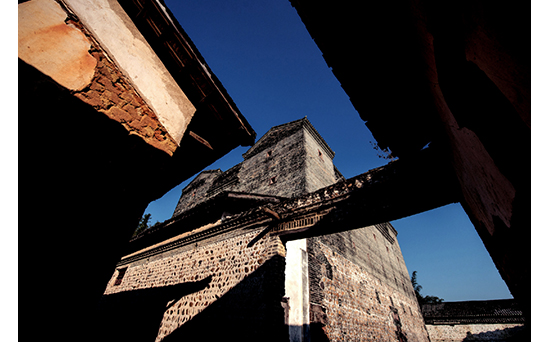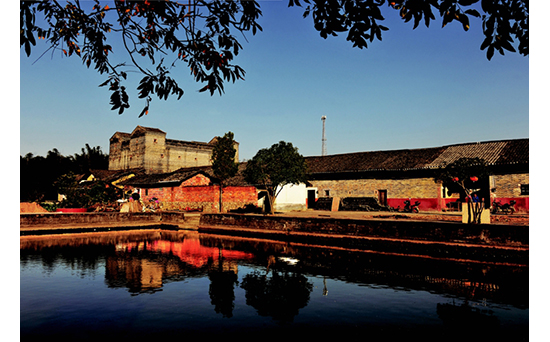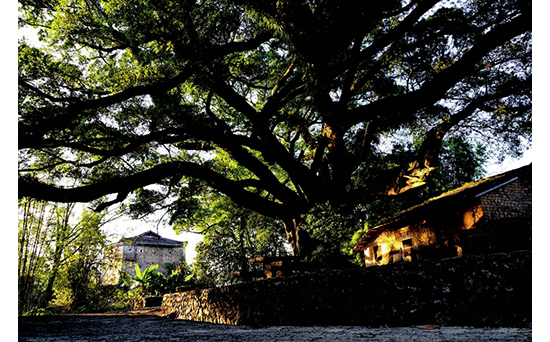Chinese “Ancient Castles” at the Eldest County in North Guangdong


Weilou in Fresh Bamboos and Ripe Pines of Dungang Village of Shixing County by Zhang Anhua

Initially built in the year A.D. 263, Shixing County in Guangdong Province of China has a history of 1750 years so far and thus enjoys the title of “First Ancient County in North Guangdong”. Within its area of 2174 square kilometers, 249 “Weilous” of Hakka people are still available. Together with “Tulou” in Fujian Province and “Diaolou” in Kaiping County of Guangdong Province, these “Weilous” are considered to be a wonder of Chinese Ancient Castles. In this sense, this time-honored county of over thousand years is reputed as the “County of Chinese Weilous”.
The concept of ancient castles naturally reminds many people of European ones. Between 1066 and 1400, European aristocrats waged constant wars to vie for land, grain, livestock and population with each other and during the course they built up so many castles that a prime period of castle architecture was realized. With legendary anecdotes with such key words as mystery, wealth, revenge and romance, those ancient castles have attracted plenty of visitors to explore the unknown secrets.
As a matter of fact, similar ancient castles are not rare in China. In the year A.D.641 , the Tibetan king Songtsen Gampo ordered to have Potala Palace built in Lhasa of Tibet in order to honor his marriage with Princess Wencheng from Tang Dynasty, and therefore the ancient castle of the highest altitude in the world came into existence. Moreover, the famous “Tulou”, widely located in Hakka residential communities in Fujian, Jiangxi and Guangdong in Southeast China as early as in A.D. 769, is regarded as the typical representative of Chinese ancient castle and listed into the World Cultural Heritage by UNESCO.
Either in Europe or in China, those ancient castles share two common characteristics: sturdy architecture and advantage of fortification as they mainly function as fortress and may vary in construction material, external layout and other functions. European ancient castles are mostly of pillar architecture in external layouts of Classical Type or Roman Type, and their owners were top aristocrats whose purpose was fortification and territory expansion. In contrast, the materials for Chinese ancient castles were mainly obtained from local sources such as soil, stone, brick and wood and integrated in a perfect balance, and those castles served for household living in addition to fortification because its owners involved ordinary people as well as officials and rich lords. In this way, both kinds of ancient castles reflect different national features in culture.
The ancient castle in Shixing County in North Guangdong ought to be one of the Chinese type and has a special name “Weilou”. Having origin from “Wubao” in Eastern Han Dynasty (A.D. 25-220), such “Weilou” underwent a rapid development in Tang and Song Dynasties and entered its peak time in Ming and Qing Dynasties. Its main materials, namely soil, sand, brick, stone, wood and tile, were all drawn on local basis and were laid together through a mixture of clay, brown sugar, glutinous rice paste, bamboo slice, Trinity earth and thatch. “Weilou” normally has an average area of over 100 square meters, plane shapes of rectangle, square, double parallel line, cross, homocentric square and other combined or complicated formality, and three to five storeys. The wall of “Weilou” can be as thick as 8.24 meters or as thin as 35 centimeters with a fortified capability against attack from homemade pistol or cannon. Several holes were drilled on the surface over the first floor for observation or shooting and inside halls, bedrooms, kitchens, grain storage room, mill, faggot room, livestock room, ammunition storehouse, well and toilets were available for daily use and defense. Local people usually nickname such castles as “cannon tower”, “corner tower”, “arrow tower” or “blockhouse”.
With an area of more than 13000 square meters, the largest “Weilou” in this county, called “Full-house Hakka Giant Weilou”, is located in Aizi Township, some 70 kilometers away to the south of Shixing County. Initiated in 1833 and completed in 1860, this “Weilou” took the local magnate Qian Rong 28 years for the security of his family and fellow people. The amazing part is its location at the intersection of two rivers and its special foundation of a rare pine timber that had been soaked in stream for thousands of years. Constituted with three respective “Weilous” in the upper, middle and lower levels, 4 spacious courtyards, 32 halls of different sizes, 16 small yards, 4 wells and 777 rooms, this compound is reputed as the “Top Weilou in Guangdong”. The smallest one, called “Slim Weilou in Shuitian Dam”, is located 6 kilometers away to the south of Shixing County. With an area of no more than 16 square meters, five storeys and elements of pebbles from the riverside, this building was the outcome of local villagers’ collective funds for sheltering from bandits.
The typical phenomenon of “Weilou” in Shixing County is attributed to the local economic and social development in the past. In history, frequent warfare in Middle China made life impossible for ordinary people and Hakka people who migrated from afar gradually became the main residents in Shixing County. The geographic location between 113.5 and 114 degrees E and between 24.5 and 26 degrees N ensures its perfect environment for grain harvest in the entire North Guangdong.
However, its location at the strategic pass of Guangdong transportation inevitably aroused trouble made by pass-by troops, bandits and outlaws. Consequently, those wise and diligent Hakka people were obliged to set up “Weilous” of such castle type everywhere so that they could escape from harassment for several days or even months. You will find that there must be some “Weilous” in every village. Historical records have proved that there once existed over 500 “Weilous” in the local history.
In Shixing County, local people endowed the “Weilou” with a cultural connotation of “everlasting peace and stability” and similar expectation was imbued with the names of many “Weilous” such as “Anjing” (literally “peaceful living”), “Yong’an” (literally “everlasting stability”) and “Yongxing” (literally “everlasting prosperity”) as good wish for local prosperity and security. In fact, those “Weilous” did protect the production and living of local residents for many times. As the official journal of Shixing County compiled in 1926 showed, lots of bandits disturbed this county on many occasions and even amounted in thousands. In the reign of Emperor Xianfeng of Qing Dynasty, varied batches of outlaws came to plunder houses and burn villages, which rendered local people in a state of great anxiety. It was “Weilou” that ensured a temporary safety at that time.
In the modern history, the “Weilou” in Shixing County has made a significant contribution to national liberation and the founding of New China. As the local researchers introduced, there are two “Weilous” in a short distance in Shensuo Town, five kilometers away to the west of Shixing County. One is called “Red Weilou” in Shenbei Village, which covers an area of over 900 square meters and has a structure of brick, stone and wood with five storeys and wall thickness of over one meter. It was built in the reign of Emperor Daoguang of Qing Dynasty and in the spring and summer of 1940, the head office of CPC Guangdong Provincial Committee secretly entered this “Weilou” for daily maneuver in Anti-Japanese battles in Guangdong Province. Then this ancient castle became a command post for Communist fighters. In May of 1942, the Committee was severely sabotaged owing to traitor’s betrayal and in February of 1945 when Shixing County was invaded by Japanese army, enemies launched a barbarian plunder and set fire to the “Weilou” for three days and nights until the last ash. From the year 2008 on, local governments at provincial, municipal and county levels launch an official plan for restoration of this “Red Weilou”. The other “Weilou”, located in Waiying Village, was built in early 1910s and currently covers an area of over 300 square meters and has five storeys and wall thickness of 1.2 meters. On August 1, 1945, over 1000 soldiers from a regiment of KMT and puppet army of Japanese invasion suddenly besieged the counter-Japanese base area in Waiying Village in order to eradicate the Communist forces and guerilla. In order to cover the retreat of Communist army and villagers, the local guerilla had a fierce battle against the invaders. As enemy outweighed in numbers, more than 30 soldiers of the local guerilla, together with some hundred villagers who failed to rush out of encirclement retreated into this “Weilou” as their base. They kept fighting for several days and nights with the enemy forces and managed to ensure the secure transition of the main cast of guerilla while dealing a heavy blow to foes. Later, the enemy forces blew out a big hole through their tunnel and conquered the “Weilou”, and altogether 112 soldiers and villagers sacrificed their lives. Upon the founding of New China, Waiying Village was renamed as “August 1st Village”.
Take a careful look at those ancient castles in Shixing County in North Guangdong through the history of “Weilou”, and we will not only appreciate the time-honored enclosing walls and towers, but also witness the Chinese nation’s advocacy for goodness, peace and harmony as well as consolidated perseverance against enemies reflected from those “Weilous”. May the culture of those ancient “Weilous” live forever.














